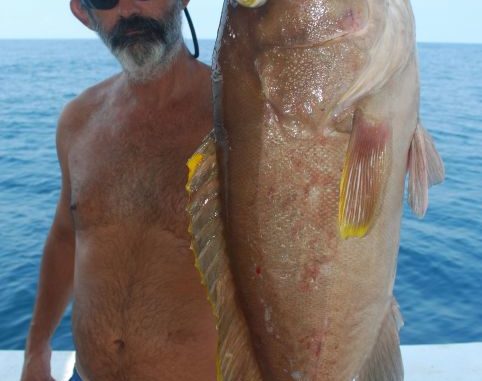
A common catch for deep-droppers
In recent years, a whole new world has opened up for offshore fishermen. Beset by lengthy season closures for gag and scamp groupers, red snappers, amberjacks and even triggerfish, as well as tight bag limits and restrictive size limits, many offshore fishermen began to wonder if owning a boat was worth it.
Some turned to tuna fishing; most found there was a limit to how many red-meated Volkswagens they wanted to reel in and eat a year.
Then along came deep-dropping.
Deep-dropping is simply a term for bottom fishing in waters deeper than 400 to 600 feet, all the way out to 1,200 feet deep. Early deep-droppers found a wide array of new species available to them, things like queen and silk snappers, longtail bass, golden tilefish, barrelfish, speckled hinds and snowy groupers.
But the poster child for deep-drop fishing is the yellowedge grouper.
Yellowedge groupers are common
With the possible exception of golden tilefish, which really prefer deeper waters, the yellowedge is the most common fish caught by deep-droppers. And just as good, maybe better yet, they are almost universally acclaimed to be the best tasting member of the entire grouper clan.
For those willing to venture into deep water, they are very common. Their range starts off of the Carolinas on the East Coast, wraps around Florida through the entire Gulf of Mexico, rings every island in the Caribbean and goes down the South American Coast to southern Brazil.
Within that range they are most common at depths of 400 to 900 feet, although juveniles can occasionally be found in waters as shallow as 100 feet. The deepest water that scientists have taken them from was 1,287 feet.
They are an oddity within the grouper family, in which most species prefer reefs, shipwrecks, rock piles and other high-profile bottom structure for their homes. The yellowedge is perfectly happy with flat bottoms.
Most preferred seem to be hard bottoms liberally encrusted with coral-like growths on them, called “live bottom.” But the fish is also found on clay, sand and even mud bottoms in their preferred depth zone.
There, each fish stakes out its own turf. Big yellowedges dominate smaller specimens and will hog the available food supply. So a baited hook will usually catch the biggest fish in an area.
Identifying the creatures
Yellowedge groupers are neither the largest nor the smallest members of the family, very commonly growing to 30 pounds and occasionally 40 pounds. They have a typical bass-sea bass body shape: A big head and mouth and a chunky, meaty body.
Their adult body color is a non-descript gray-brown, but their dorsal (back), pectoral (side), anal (belly) fins and sometimes their tail fins are edged in brilliant yellow.
Small yellowfin groupers’ bodies are often marked with orderly, widely spaced rows of white spots. These spots will sometimes also be present on larger fish, but they rapidly fade after the fish is landed.
White body spots are a signature marking on their close deep-water relative, the snowy grouper. But snowy groupers never have yellow edges on their fins.
The yellow thing gets a little confusing at first glance, but is easily sorted out. The yellowmouth grouper also has small yellow fin margins, but has a mouth heavily spashed with yellow, something never seen in yellowedge groupers.
The yellowfin grouper has wide yellow margins on its fins, but never has an evenly-colored body like the yellowedge grouper. They are most commonly colored gray or pinkish, and heavily marked with mottling or blotches.
An odd lifestyle
Yellowedge groupers, like other groupers, have an odd sex life. Every one of them begins life after hatching as a female. At about 24 inches long and 2 to 3 years old, they begin to spawn.
After several years as spawning females, some of them flip gender, becoming males. It isn’t known what the trigger is for the sex change. In other, more studied “protgynous hermaphrodite” fishes, it appears that the removal of males from the population triggers females to change to males.
In any case, the change apparently happens very quickly, as biologists seldom examine a fish in transition from female to male. Studies show that in the Gulf of Mexico, females average 27 inches long and males average 35 inches.
Not every female will change sex in her lifetime. Females as long as 43 inches long have been captured. Females range in age from 2 to 29 years old, and males range from 13 to 75 years old. Females begin turning into males at about 23 inches long and 13 years of age.
Females outnumber males by an average of two to one.
Spawning takes place from January through October, peaking in May to September. Nothing is known about how many eggs they spawn at each spawning or over the whole season, nor how often they spawn each year.
The unique lifestyle of the yellowedge grouper gives cautious biologists reason for worry of overfishing for two reasons. First, they are long-lived fish that are slow to mature.
Second, since they are protogynous hermaphrodites and males are found only in the larger (and more aggressive and easy to catch) size classes, heavy fishing pressure on larger fish may take enough males to lower spawning success in this species.




